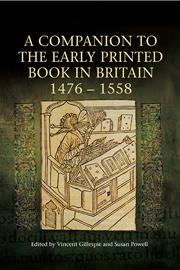Book contents
- Frontmatter
- Contents
- List of Illustrations
- List of Contributors
- Preface
- Acknowledgements
- Abbreviations
- Chronology of the Period
- Introduction
- I THE PRINTED BOOK TRADE
- 1 From Manuscript to Print: Continuity and Change
- 2 Printers, Publishers and Promoters to 1558
- 3 The Latin Trade in England and Abroad
- II THE PRINTED BOOK AS ARTEFACT
- III PATRONS, PURCHASERS AND PRODUCTS
- IV THE CULTURAL CAPITAL OF PRINT
- Index of Manuscripts
- Index of Printed Books
- General Index
3 - The Latin Trade in England and Abroad
from I - THE PRINTED BOOK TRADE
Published online by Cambridge University Press: 05 April 2014
- Frontmatter
- Contents
- List of Illustrations
- List of Contributors
- Preface
- Acknowledgements
- Abbreviations
- Chronology of the Period
- Introduction
- I THE PRINTED BOOK TRADE
- 1 From Manuscript to Print: Continuity and Change
- 2 Printers, Publishers and Promoters to 1558
- 3 The Latin Trade in England and Abroad
- II THE PRINTED BOOK AS ARTEFACT
- III PATRONS, PURCHASERS AND PRODUCTS
- IV THE CULTURAL CAPITAL OF PRINT
- Index of Manuscripts
- Index of Printed Books
- General Index
Summary
Although William Caxton brought printing with moveable type to England in 1476, it was to be about another century and a half before England was ‘selfsufficient’ in its printing needs. In the meanwhile it became a good market for Latin printed books of all sorts. Liturgical and devotional works and also Latin works of theology and canon law would have been crucial to members of the clergy in their dealings with each other, the laity, the church and state. Works of philosophy, classics and grammar would have been aimed at the academic and student bodies in the universities. This chapter will examine the kind of books which were being brought in, who was bringing them in, and who was buying or being given them.
Before Caxton's arrival in England, demand for books was met solely from abroad; the position in Scotland was the same up till the early part of the sixteenth century. Once started, the importation of printed books into both England and Scotland continued even after printing presses had been established in both countries. The trade in printed books took off in earnest in the 1470s, with a marked increase in the 1480s into the 1490s. Lotte Hellinga has noted that ‘for the whole of this period the scale of dependence on provision from overseas is an exceptional characteristic of the use of books in the British Isles. It not only shaped the nature of printing in England and Scotland, it also had a profound influence on the Continental book-trade, in the Netherlands, in particular on that of Antwerp and Louvain’.
- Type
- Chapter
- Information
- Publisher: Boydell & BrewerPrint publication year: 2014

